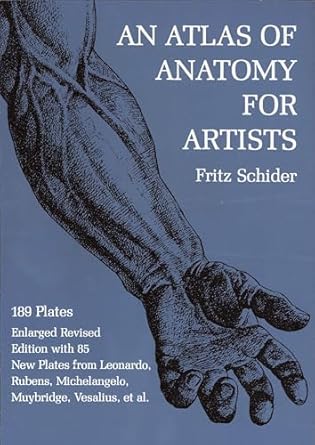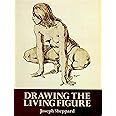AN ATLAS OF ANATOMY FOR ARTISTS
By FRITZ SCHIDER, BERNARD WOLFDover Publications, Inc.
Copyright © 1957 Dover Publications, Inc.
All rights reserved.
ISBN: 978-0-486-20241-9
Contents
Preface To The Third American Edition,
Preface To The Second American Edition,
Introduction,
Sources of Illustrations,
Plates,
An Annotated Bibliography of Books on Human Anatomy of Interest to Artists,
INTRODUCTIONPLATES 1 and 2. The Skeleton.
Plates 1 and 2 show the skeleton of a young man from the front, side, and back.
Note: The female skeleton is clearly differentiated from the male by the small face and skull, the narrow, short thorax, and particularly the more rounded pelvis (compare the drawings).
PLATE 3. The Various Shapes of Bones.
Fig. 1 demonstrates the groove between the two tuberosities at the upper end of the humerus, a typical bone groove, and the oval rough area of the humerus (insertion of the deltoid muscle).
Fig. 2 demonstrates the linea aspera, the róugh line on the posterior aspect of the femur (origin and insertion of thigh muscles), a typical bone ridge; the head of the femur, the upper cartilage-covered end of the femur, with the femoral neck and the two femoral trochanters.
Fig. 3 demonstrates the crest of the tibia, the upper portion of the S-shaped edge of the tibia, a typical bone edge.
Fig. 4 demonstrates the ischial spine, the pointed process of the ischium, and the acetabulum which serves to receive the head of the femur.
Fig. 5 shows a tubular bone sawn across with its marrow cavity.
PLATE 4. The Types of Joints.
The various joints are classified according to the shape of the articular surfaces. A. Ball and Socket Joints.
Fig. 1. The ligaments between the humerus and scapula form the joint capsule.
Fig. 2. The ligaments between the femur and pelvis.
The ball and socket joint consists of a spherical head which fits into a cavity, the acetabulum, and which allows motion in all directions. Flexion, extension, adduction, and circumduction are possible in this type of joint. B. Hinge Joints.
Fig. 3. The joints of the fingers, the inter-phalangeal joints, are shown as examples of this type.
In a hinge joint, one bone has a transverse convex cylindrical surface and the other bone shows the reciprocal contour. Only flexion and extension are possible in such a joint.
C. Combination Type of Joint.
Fig. 4. The elbow joint is shown as an example of this type of joint. Three or more articular surfaces with various shapes are involved: the joint between the ulna and the humerus forms a hinge joint while the joint between the radius and the humerus is of the ball and socket type. In addition, there is a special joint between the ulna and radius. In this combined joint, pronation and supination, flexion and extension are possible. (Pronation refers to the motion of rotating the palm of the hand inwards towards the body; the pronated position of the forearm and hand is the position assumed after maximum inward rotation—the palm then faces outwards. Supination refers to the opposite motion, i.e. rotating the palm outwards away from the body; the supinated position is the position assumed after maximum outward rotation—the palm faces forward and slightly outwards.)
D. Immobile Type of Joint.
Fig. 5. The joints between the individual wrist (carpal) and ankle (tarsal) bones and between the carpal and metacarpal, tarsal and metatarsal bones are examples of this type.
PLATE 5. Schematic Cross-section Through a Joint.
The important features are clearly labeled on the plate.
THE BONES OF THE HUMAN BODY
I. The Bones of the Skull.
PLATES 6 and 7.
Plate 6, Fig. 1 is a view of the skull from below; Fig. 2, from the front. In Fig. 1, note:
A. The two occipital condyles with joint surfaces which articulate with concave facets on the first cervical vertebra.
B. The two mandibular fossae in which the articular processes of the mandible move.
C. The occipital protuberance to which the ligamentum nuchae ("ligament of the neck") isattached.
D. The mastoid processes, the styloid processes, and the external occipital crest which serve for the origin or insertion of muscles.
E. The foramen magnum is the connection between the cranial cavity and the vertebral (spinal) canal.
Plate 6, Fig. 2. In this drawing, significant features as far as external appearance is concerned are:
A. The two frontal prominences — rounded protuberances more definitely marked in children and women than in men;
B. The two superciliary arches — slender ridges above the orbits more distinctly marked in men than in women or children;
C. The glabella — a small, flat surface between the superciliary arches;
D. The temporal lines — characteristically individual lines which form the lateral margins of the forehead;
E. The nasal bones;
F. The zygomatic bones with their very prominent zygomatic processes forming the anterior portions of the zygomatic arches;
G. The chin formed by the central part of the mandible.
Plate 7, Figs. 1 and 2 show the skull of the newborn, viewed from above and from the left side. Sutural lines have not formed as yet. Instead, membrane-covered spaces are present between bones concerned. The frontal bone consists of two portions, unfused as yet.
Fig. 3 demonstrates the senile skull. As a result of the teeth falling out, the mandible is thinned, the angle of the mandible obtuse, the mandible extends beyond the maxilla, and the chin protrudes.
Figs. 4 to 6 demonstrate the contours of three different skulls with their sutures.
II. The Bones of the Trunk. PLATES 8, 9, and 10.
These plates include the bones of the trunk consisting of the spinal column and the thoracic cage.
A. The spinal column of the adult consists of 24 distinct (true) vertebrae, the sacrum, and the coccyx. The 24 true vertebrae are made up of 7 cervical vertebrae, 12 thoracic vertebrae, and 5 lumbar vertebrae. The sacrum consists of 5 fused (false) vertebrae; the coccyx, 4 fused vertebrae.
B. The thoracic cage includes the sternum and 12 pairs of ribs. The upper 7 ribs (true ribs) are directly connected to the sternum by their costal cartilages; of the lower 5 ribs (false ribs), the eighth, ninth, and tenth are attached by their costal cartilages to the costal cartilage of the seventh rib, forming thereby the inferior thoracic margin, clearly indicated in the living. The eleventh and twelfth ribs lie within the posterior abdominal wall with their anterior ends unattached ("floating" ribs).
PLATE 11. Types of Vertebrae.
Fig. 1. The first cervical vertebra (atlas); note the concave articular facets into which the occipital condyles fit.
Fig. 2. The second cervical vertebra (axis); note the tooth-shaped process (the dens).
Fig. 3. The first and second cervical vertebrae, articulated.
Fig. 4. The seventh cervical vertebra; note a bifurcated spinous process and perforated transverse process.
(N.B. the spinous process of the seventh cervical vertebra is rarely bifurcated but usually presents a single tubercle easily palpable beneath the skin, as indicated by the name "vertebra prominens" sometimes used for this vertebra.)
Figs. 5 and 6. The first thoracic vertebra; note the articular facets for the ribs.
Fig. 7. The fifth lumbar vertebra; note the massive body and strong spinous process.
PLATES 12 and 13. Movements of the Spinal Column.
The nodding motion between the head and first cervical vertebra and the rotatory motion between first and second cervical vertebrae are not shown. Only the movements of the spinal column from the third cervical vertebra to the sacrum are illustrated: forward and backward flexion, lateral (right and left) flexion, and rotation about the longitudinal axis.
Forward and backward flexion are performed predominantly in the cervical and lumbar portions. For this purpose, the thoracic portion of the spine with the thorax may be considered as fixed. Also, lateral flexion occurs in the main in the cervical and lumbar portions. Rotation about the longitudinal axis occurs, on the other hand, predominantly in the thoracic portion of the spine and particularly in its lower part. Rotation from the eighth to the twelfth thoracic vertebrae may be as much as 28 degrees. Total amount of rotation from the third cervical vertebrae to the sacrum is about 47 degrees.
III. The Bones of the Upper Extremity. PLATES 14 and 15.
The bones of the upper extremity may be said to include:
A. The clavicle and the scapula which together form the shoulder girdle;
B. The humerus;
C. The two bones of the forearm (ulna and radius);
D. The bones of the wrist;
E. The bones of the palm and fingers.
Subdivisions B, C, D, E together make up the upper extremity proper or the "free" portion of the upper extremity.
Plate 14, Fig. 1 illustrates the bones of the upper extremity as seen from the front with the forearm hanging down at the side naturally.
Note: This position of the forearm is midway between supination and pronation. For purposes of strict anatomical description, the "anterior view" of the forearm is the anterior aspect of the supinated forearm with palm facing directly forward. The outer aspect of the forearm and hand in this position is also called the lateral or radial side. The inner aspect is also called the medial or ulnar side. "Radial" and "ulnar" refer to the two bones of the forearm.
Note the S-shaped clavicle, the apex of the shoulder formed by the acromion process of the scapula, the coracoid process of the scapula, the humerus with its characteristic joint surfaces, the bones of the forearm articulating with the humerus, and finally, below the forearm, the bones of the wrist, palm, and fingers (carpal bones, metacarpal bones and phalanges).
Plate 14, Fig. 2 illustrates the bones of the upper extremity, with pronated forearm, as seen from the medial (or inner) side. Note the foreshortened clavicle and acromion process, the medial epicondyle of the humerus, the crossed bones of the forearm, and the lateral aspect of the wrist and hand.
Plate 15, Fig. 1 illustrates the bones of the upper extremity with forearm pronated, as seen from the lateral (or outer) side. Note the axillary border of the scapula, the foreshortened clavicle, the clearly demonstrated head of the humerus and lateral epicondyle of the humerus, the adjacent S-shaped bones of the forearm, and the side view of the wrist and hand.
Plate 15, Fig. 2 shows the bones of the upper extremity, forearm pronated, as seen from behind. Note that the scapula is seen in its entire extent and that both epicondyles of the humerus are well demonstrated. (Extensor muscles are attached to the lateral epicondyle; flexor muscles to the medial epicondyle.) The ulna is well seen, especially its upper end or olecranon, and its lower end, the styloid process and the head which form a prominence just above the wrist.
IV. The Bones of the Lower Extremity. PLATES 16 and 17.
The benes of the lower extremity consist of:
A. The two innominate bones (Each innominate bone is made up of three bones distinct in development but fused in the adult—the pubis, ischium, and ilium. The innominate bones, the sacrum, and coccyx, together, form the pelvis, sometimes called the pelvic girdle.);
B. The femur;
C. The leg bones (tibia and fibula);
D. The bony structure of the foot.
Subdivisions B, C, and D make up the lower extremity proper or "free" lower extremity.
Plate 16, Fig. 1 shows the bones of the lower extremity as seen from the front. Note the half-pelvis, the innominate bone with well-marked anterior superior and inferior spines, the femur with its well-developed ends, the patella, the two leg bones, and the bones of the foot viewed from above and in front. The bones of the foot consist of the tarsal bones, the metatarsal bones, and the bones of the toes (phalanges).
Plate 16, Fig. 2 shows the bones of the lower extremity as seen from behind. Note the half-pelvis, the innominate bones with well-marked posterior superior and inferior spines, the ischium with its tuberosity and spine, the femur with the two tro-chanters at its upper end and the two condyles at its lower end, the tibia articulating with the femur at the knee joint, the fibula, and the bones of the foot.
Plate 17, Fig. 1 shows the bones of the lower extremity from the medial aspect. Note the foreshortened pelvis, the medial condyle of the femur, the prominent tibial tuberosity at the upper end of the tibial crest, and the medial aspect of the bones of the foot.
Plate 17, Fig. 2 shows the lateral view of the bones of the lower extremity. Note the half-pelvis with prominent iliac crest, the femur and patella, the tibia with its tuberosity, the fibula with the fibular head at its upper end, and the lateral aspect of the bones of the foot.
V. The Articulations of the Human Body. PLATES 18 and 19.
Plate 18 shows the ligamentous capsule of the hip joint and the ligaments of the elbow joint.
Plate 19 shows the knee joint with and without its capsule. The capsule is re- enforced by accessory ligaments, not only on the outside of the joint but also within the joint as cruciate ligaments. Note the position of the two fat pads below the patella. These fat pads determine to a considerable extent the external appearance of the knee.
THE MUSCLES OF THE HUMAN BODY
I. General Considerations on the Types of Muscles and Tendons. PLATE 20.
A typical muscle may be said to consist of a central, red, fleshy or "muscular" portion (the belly) which changes its length and a tendon which does not alter its length but is stretched when the muscular portion is shortened.
Plate 20, Fig. 1 is a schematic representation of a muscle to clarify the terminology used. In general, the "origin" of a muscle is the uppermost muscle attachment or the muscle attachment nearest the midline of the body, while the opposite muscle attachment is called the "insertion." Some muscles are subdivided into a "head," any expanded portion at the origin, a central portion (the muscle belly), and a terminal portion or tail. Tendons appear in several forms:
A. As terminal tendons, attached at the end of the muscle, e.g. the gastrocnemius muscle and the Achilles' tendon (Fig. 3).
B. As interstitial tendons, inserted in the substance of the muscle belly, e.g. the tendinous "inscriptions" of the rectus abdominis muscle Fig. 4).
C. As sheets, bands, or strands which frequently extend from the origin or insertion deep into the muscle substance, e.g. the tendinous strands in the extensor carpi ulnaris muscle (Fig. 2).
D. As aponeuroses—the term used for broad extensive tendon sheets, e.g. the aponeurosis of the external oblique muscles (overlying the right rectus abdominis muscle in Fig. 4).
E. As tendinous sheets or bands which cover a portion of the muscle belly, e.g. the tendons of the gastrocnemius muscle (Fig. 3).
It is also possible to distinguish several types of muscle bellies:
A. Muscles with two, three, or more heads which arise at different sites and fuse into one belly, e.g. the biceps muscle and the triceps muscle of the arm and the quadriceps muscle of the thigh.
B. Muscles with a single belly which divides into several slips which insert independently, e.g. the flexors and extensors of the fingers and toe.
C. Broad muscles which, besides contracting, serve also to cover or protect body cavities, e.g. the pectoralis major muscle, and the external oblique abdominal muscle.
D. Ring-shaped muscles, e.g. the circular muscles surrounding the eyes and mouth.
E. "Skin" muscles which arise from some deeper site but insert into the skin, e.g. the platysma muscle in the neck.
Note: The term fascia is applied to a membranous connective tissue sheet which surrounds a muscle or muscle group.
II. The Muscles of the Head. PLATES 21 through 24.
The muscles of the head may be divided into:
A. The muscles associated with the lids;
B. The muscles associated with the mouth;
C. The muscles for the nose;
D. The muscles over the top of the skull;
E. The muscles associated with the lower jaw.
A. Muscles associated with the lids. Orbicularis oculi muscle (Plate 21).
Origin: Medial angle of the eye, lachrymal bone and medial ligament of the lid.
Insertion: Interdigitates with fibers at origin.
Action: Closes the eyelids.
(Continues...)Excerpted from AN ATLAS OF ANATOMY FOR ARTISTS by FRITZ SCHIDER, BERNARD WOLF. Copyright © 1957 Dover Publications, Inc.. Excerpted by permission of Dover Publications, Inc..
All rights reserved. No part of this excerpt may be reproduced or reprinted without permission in writing from the publisher.
Excerpts are provided by Dial-A-Book Inc. solely for the personal use of visitors to this web site. 





























